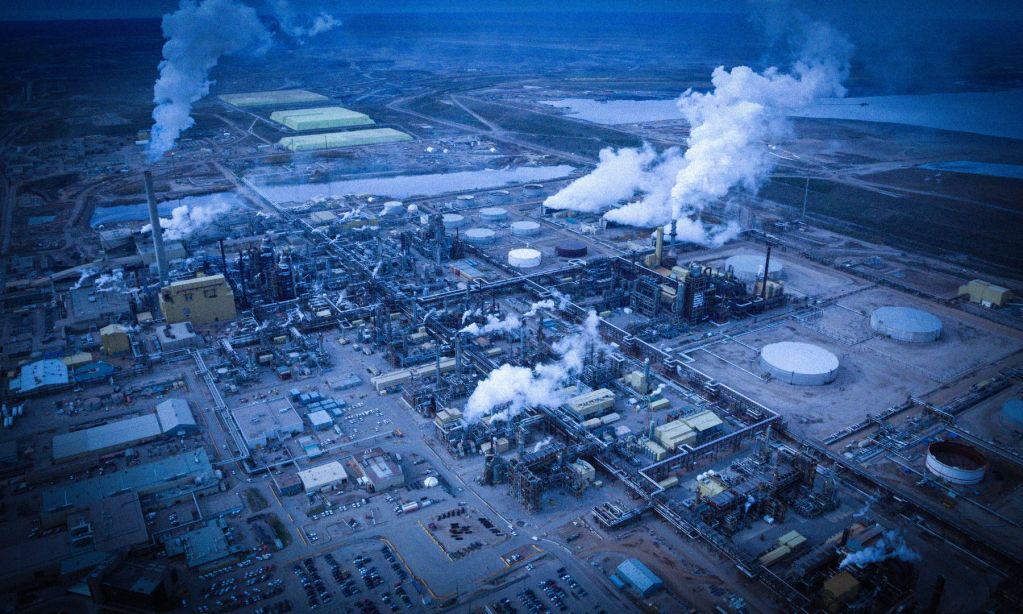The following is a re-print of a special edition of Shift Storm, the CCPA's monthly newsletter which focuses on the intersection of work and climate change. Click here to subscribe to Shift Storm and get the latest updates straight to your inbox as soon as they come out.
The oil sands are destined for collapse. The only question is how soon.
Canadian governments and the oil industry are banking on oil production rising or at least remaining flat through 2050 before tapering off in the latter half of the century. To square this scenario with their climate claims, governments and industry are gambling on carbon capture technologies to achieve net-zero upstream emissions from the sector… without actually reducing total oil production.
Whether or not that’s actually possible, this strategy rests on a crucial, unspoken assumption—that despite 149 countries committing to achieve net-zero emissions in the coming decades, the world will continue to buy Canadian oil indefinitely.
But what if they’re wrong?
There is a real and growing possibility that demand for Canadian oil exports will fall sooner and faster than anticipated. Not only because of falling demand for oil in general, but specifically because the oil sands are among the costliest and most emissions intensive sources of oil in the world.
No Canadian politician or government can save the oil sands if international demand for that dirty fuel dries up.
As new research from the CCPA and Ecojustice explains, falling demand for oil sands exports would be devastating for the Albertan workers, communities and governments that have no plans in place for this possible future.
Heads in the Sands, co-authored by myself and Ecojustice lawyer Matt Hulse, presents an economic model of the oil sands in a global net-zero scenario. It paints an ugly picture for the industry. Production from the oil sands stays relatively steady for the next few years before collapsing in the 2030s and falling more than 80 per cent by 2050. A production decline driven by changes in global demand would have far greater consequences than any domestic policy to reduce emissions from the oil sands.
In this scenario, oil sands projects fall like dominoes, starting with the highest-cost and highest-emitting producers in the 2030s. By 2050, only a handful of projects are still producing and at well below their maximum productive capacity.
Total employment in the sector falls by 90 per cent in this period. Royalty and tax payments generated by the industry fall even faster, blowing a huge hole in the provincial budget. Shuttered projects leave behind $70 billion in stranded assets and more than $50 billion in unfunded environmental cleanup costs. All of these figures are broken down in more detail in the report.
It’s a fate Alberta is unsurprisingly unwilling to entertain, and oil backers will be quick to dismiss this scenario as unlikely or even impossible. What are the odds the whole international community follows through on their climate commitments?
Think about it this way. If stable oil demand through 2050 is the best case scenario for the Canadian oil sands, then rapid decarbonization is the worst case scenario. If reality falls anywhere in the middle, Alberta needs to be prepared for at least some oil sands projects to shut down prematurely. And if reality falls closer to the worst case scenario—which, to be clear, is absolutely essential from a climate perspective—then Alberta needs to be prepared for a deep and sustained economic disruption as early as the 2030s.
The re-election of Donald Trump in the U.S., which we will unpack in the next regular edition of Shift Storm, would seem to cast doubt about the threat posed to the oil sands by international climate action. Ironically, however, increased competition from resurgent U.S. oil producers in a context where oil demand continues to fall globally would be even worse for the Canadian oil sands. The possible imposition of 10 to 20 per cent tariffs on Canadian energy exports to the U.S. would just be the cherry on top.
The main takeaway from this new research is simply that workers, communities and governments need to make a plan for the end of the oil sands. In no scenario does the oil sands industry shut down overnight, but, in a world moving rapidly to decarbonize, the dominoes start to fall in the 2030s. The longer Canada and Alberta wait to prepare, the more costly and complicated the transition will be.







